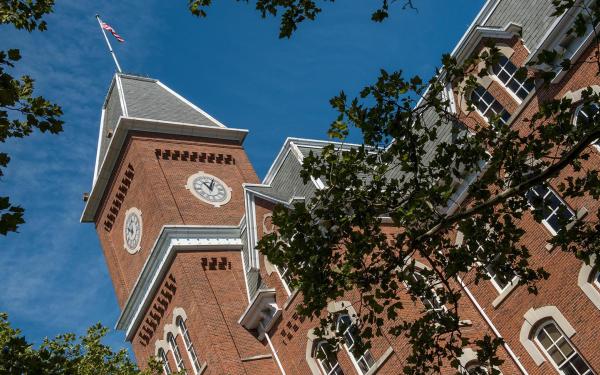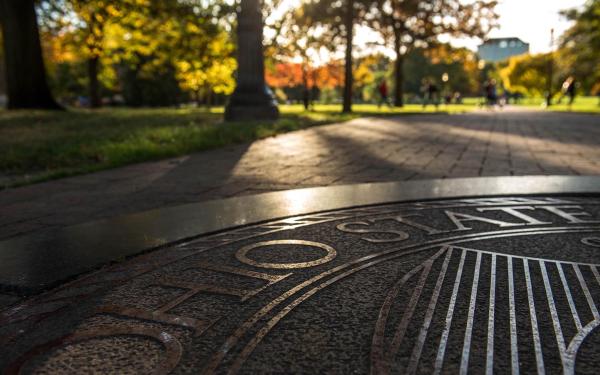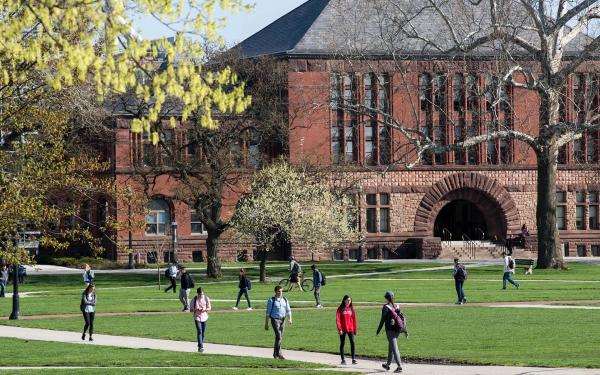Congratulations on your admission to The Ohio State University!
We invite you to join us for our annual Experience Arts and Sciences Day. This exclusive event provides newly admitted students and their families an enhanced preview of just how much the College of Arts and Sciences at Ohio State has to offer.
Saturday, February 14, 2026
9:45 a.m. to 5 p.m.
Ohio State's Columbus campus
Please register by February 9.
9:45-10:45 a.m.
Registration, check-in and academic fair
Physics Research Building Atrium
191 W. Woodruff Ave.
10:45-11 a.m.
Travel to Independence Hall
1923 Neil Ave.
11-11:15 a.m.
Welcome by Andrew Martin, Associate Dean for Undergraduate Education, College of Arts and Sciences
100 Independence Hall
1923 Neil Ave.
11:15-12 p.m.
Admitted Student post-acceptance processes
100 Independence Hall
1923 Neil Ave.
12-12:15 p.m.
Travel to next session
12:15-1:15 p.m.
Sample class 1 (Select one to attend as part of the registration process. View class descriptions below.)
- Explore the world of languages
by Janice Aski and other world language faculty
Hagerty Hall, Room 180
1775 College Rd. S
- Searching for the Giant Ground Sloth Megalonyx and a tour of historic Orton Hall
by Loren Babcock
Orton Geological Museum, Orton Hall Room 110
155 S. Oval Mall
- Is GATTACA on the Way? Using the CRISPR/Cas 9 Bacterial Defense System to Edit the Genome
by Susan Cole
Stillman Hall, Room 100
1947 College Rd.
- Freedom in the 21st Century
by Eric MacGilvray
Journalism Building, Room 270
242 W. 18th Ave.
- Why are our bodies unremarkable?
by Habiba Chirchir
Journalism Building, Room 371
242 W. 18th Ave.
- Thinking about the Good Life
by Steven Brown
Journalism Building, Room 239
242 W. 18th Ave.
- HIV: From Microbiology to Macro History
by Jesse Kwiek and Thomas McDow
Psychology Building, Room 10
1835 Neil Ave.
- Learn more about the Universe with the Department of Astronomy at the Arne Slettebak Planetarium
by Wayne Schlingman
Smith Laboratory
174 W. 19th Ave.
- Symbiotic Mind: How AI is Creating the Next Wave of Creativity and Innovation
by Michael Hardesty
Journalism Building
242 W. 18th Ave.
1:15-2:30 p.m.
Lunch on your own
University dining locations
2:30-3:30 p.m.
Sample class 2 (Select one to attend as part of the registration process. View class descriptions below.)
- Explore the world of languages
by Janice Aski and other world language faculty
Hagerty Hall, Room 180
1775 College Rd. S
- Searching for the Giant Ground Sloth Megalonyx and a tour of historic Orton Hall
by Loren Babcock
Orton Geological Museum, Orton Hall Room 110
155 S. Oval Mall
- Is GATTACA on the Way? Using the CRISPR/Cas 9 Bacterial Defense System to Edit the Genome
by Susan Cole
Stillman Hall, Room 100
1947 College Rd.
- Freedom in the 21st Century
by Eric MacGilvray
Journalism Building, Room 270
242 W. 18th Ave.
- Why are our bodies unremarkable?
by Habiba Chirchir
Journalism Building, Room 371
242 W. 18th Ave.
- Thinking about the Good Life
by Steven Brown
Journalism Building, Room 239
242 W. 18th Ave.
- HIV: From Microbiology to Macro History
by Jesse Kwiek and Thomas McDow
Psychology Building, Room 10
1835 Neil Ave.
- Learn more about the Universe with the Department of Astronomy at the Arne Slettebak Planetarium
by Wayne Schlingman
Smith Laboratory
174 W. 19th Ave.
- Symbiotic Mind: How AI is Creating the Next Wave of Creativity and Innovation
by Michael Hardesty
Journalism Building
242 W. 18th Ave.
3:30-3:45 p.m.
Travel to 100 Independence Hall for optional campus tour
1923 Neil Ave.
3:45-5 p.m.
Optional Campus Tour
Departs from 100 Independence Hall
1923 Neil Ave.
Explore the world of languages
by Janice Aski and other world language faculty (Hagerty Hall Room 180)
The process of learning a new language provides many intercultural skills that are transferable to working with people from backgrounds different from your own. Hear it from Ohio State students.
In fact, Intercultural Competence is rated among the top skills needed for working in the future. This session will begin with a short introduction by the director of the Center for Languages, Literatures, and Cultures, who will briefly discuss Ohio State languages and the programs and scholarships available for study and internships abroad. You will then participate in a surprise language lesson and find out for yourself how learning a new language contributes to your future life and career.
Searching for the Giant Ground Sloth Megalonyx and a tour of historic Orton Hall
by Loren Babcock (Orton Geological Museum, Orton Hall, Room 110)
The Orton Geological Museum’s renowned collection of fossils, minerals, rocks, building stones, and meteorites includes specimens dating to the early years of exploration in North America. The museum is home to the oldest mounted skeleton of a fossil animal in America, the giant ground sloth Megalonyx. Exploring Orton Hall provides an opportunity to glimpse at Ohio State’s early history, learn about some of the university’s cherished treasures, and experience the excitement of a modern scientific investigation on the fossils of a fascinating Ice Age mammal.
Is GATTACA on the Way? Using the CRISPR/Cas 9 Bacterial Defense System to Edit the Genome
by Susan Cole (Stillman Hall Room 100)
The last five years have seen an explosion of interest in a simple bacterial defense system called CRISPR. Some bacteria use this system to protect themselves from invading viruses. Scientists have harnessed CRISPR to edit the DNA of research animals and possibly ourselves. This procedure could someday allow scientists to make changes to the human genome with pinpoint precision. What implications does this have for research? For medicine? For human evolution and society? We will discuss how CRISPR works, what scientists currently use it for, and what changes could be on the way soon.
Freedom in the 21st Century
by Eric MacGilvray (Journalism Building, Room 270)
Almost everyone is committed to equality in one form or another — moral, social, political, or economic. But there is significant disagreement about what kinds of equality matter and what intervention might be justified to achieve them. We will discuss some leading theories of equality — luck egalitarianism, sufficiency views, and relational equality — as a way of exploring the nature and limits of our egalitarian commitments.
Why are our bodies unremarkable?
by Habiba Chirchir (Journalism Building, Room 371)
This class will discuss the changes that we see in our skeletons compared to our ancestors that are associated with domestication and will draw from the dog domestication record.
Thinking about the Good Life
by Steven Brown (Journalism Building, Room 239)
Is happiness a state of mind, or something more? Can we be mistaken about our happiness? Participants in this sample class will engage in philosophical reflection and discussion in order to clarify what really matters in their lives.
HIV: From Microbiology to Macro History
by Jesse Kwiek and Thomas McDow (Psychology Building, Room 10)
This course is an interdisciplinary exploration of HIV/AIDS. An estimated 39 million people around the world were living with HIV, a number startling close to the estimated number of people who have died from AIDS since 1981. Unlocking the virological secrets of HIV/AIDS has been one of the grand scientific challenges of the last three decades, and the disease remains one of the world’s most serious challenges to human health and development. The burden of the disease is uneven globally, and sub-Saharan Africa, where the disease originated, is home to 69% of those living with HIV today. How did this virus and this global pandemic come to be? The course considers the origin of the virus and traces its evolution at both the molecular level and within in its global historical context. Team-taught by a virologist (Kwiek) and a historian (McDow), the goal of the class is to put the sciences and humanities in conversation.
Learn more about the Universe with the Department of Astronomy at the Arne Slettebak Planetarium
by Wayne Schlingman (Smith Laboratory)
Hear about how astronomers explore the universe and be amazed at how small the Earth is compared to the entirety of space.
Symbiotic Mind: How AI is Creating the Next Wave of Creativity and Innovation
by Michael Hardesty
As Artificial Intelligence rapidly integrates into every field, the conversation must shift from fear to strategic partnership. This talk will move beyond the headlines about job replacement to explore the powerful, collaborative relationship emerging between human and machine—the "Symbiotic Mind." This essential lecture will equip undergraduates with the "Third Intelligence" mindset—the ability to strategically collaborate with AI—which is critical for success in the future economy. Don't just adapt to AI; learn to multiply your own potential.



